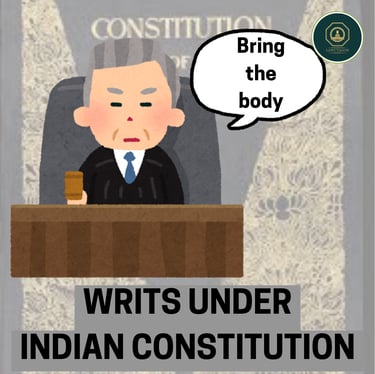The Power and Impact of Writs in the Indian Constitution
In this blog, the powers of the Supreme Court and High Courts to issue writs under the Indian Constitution are discussed. It covers the types of writs available for protecting fundamental rights, explains the doctrine of Res Judicata, and provides case law examples. The significance and conditions for issuing each type of writ, including Habeas Corpus, Mandamus, Quo Warranto, Prohibition, and Certiorari, are elaborated.
Prerna from Institute of Law, Kurukshetra University
7/14/20246 min read


INTRODUCTION:
The Constitution of India has vested the Supreme Court and the High Courts with significant powers, including the special power to issue writs, to ensure justice among the people. Writs are formal written orders issued by the court to any person, authority, or organization, directing them to do or abstain from doing a specific act. Writs are a remedy available under the Constitution of India for the violation of fundamental rights. Everyone in India has the valuable right to seek redress by filing a petition in either the Supreme Court or the High Courts if anyone violates their fundamental rights. This important provision empowers the Supreme Court to issue writs under Article 32 of the Constitution. Similarly, Article 226 empowers the High Court to issue writs, ensuring the protection of fundamental rights.
DOCTRINE OF RES JUDICATA:
The doctrine of Res Judicata demonstrates that if an individual files a writ petition in the Supreme Court and the issue is decided by the Supreme Court under Article 32 of the Constitution of India, the same issue cannot be raised in the High Court under Article 226, and vice versa.
TYPES OF WRITS:
There are five types of writs under the Constitution of India that the Supreme Court and the High Courts can issue. These are:
Habeas Corpus
Mandamus
Quo Warranto
Prohibition
Certiorari
HABEAS CORPUS:
The literal meaning of Habeas Corpus is “you may have the body of.” This writ is invoked when there is an unlawful detention of any person. The court may order the authority to present the person before the court and explain the reason for their detention. If the detention is unlawful at the time it was made but suddenly becomes lawful, the writ would be refused. The applicant must show a prima facie case of unlawful detention. The petition can be filed by the person under detention or by anyone on their behalf. The court possesses the power to grant interim bail while dealing with the petition of Habeas Corpus.
Case Law Example: Rudul Sah v. State of Bihar.
Rudul Sah was imprisoned for the murder of his wife and was acquitted in 1968. However, even after his acquittal, he remained in jail for another 14 years. A writ petition was filed under Article 32 of the Constitution of India seeking his release and compensation for unlawful detention. The court held the detention of Rudul Sah as unlawful and a violation of his fundamental rights and personal liberty under Article 21 of the Constitution and compensated him for the same.
ADM Jabalpur v. Shivkant Shukla: The case of ADM Jabalpur v. Shivkant Shukla is also known as the Habeas Corpus case. During the Emergency imposed by Indira Gandhi in 1975, many political leaders and activists were arrested without being heard. All fundamental rights, including the right to move any court, were suspended. The Court held that during an emergency, no one could approach the court for any unlawful detention or curtailment of any fundamental right. The Supreme Court's decision was widely criticized.
Rules of Habeas Corpus:
The person must be arrested without violating any law.
The petition can be filed by the detainee, any person on their behalf, or any stranger in the public interest.
Detention should not be legal.
MANDAMUS:
The literal meaning of Mandamus is ‘the order’ or ‘to command’. The writ of mandamus is an important tool used by superior courts to ensure that public authorities, organizations, or lower courts fulfil their legal duties. It ensures accountability and upholds the rule of law in the administration of public services and justice. The writ of mandamus may be issued if any public authority fails to perform its legal duty, ordering it to perform its particular legal duty or function. It is a discretionary remedy aiming at the performance of public duties and ensuring that public authorities fulfil their duties as prescribed by law. The rule of mandamus does not apply to any private individual. However, if there is collusion between the state and any private individual or organization, the Court may have the power to issue a writ of mandamus against them.
Case Law Example: Sharif Ahmad v. HTA, Meerut (1977) The petitioner requested the Supreme Court to enforce the tribunal’s rulings after the respondent refused to comply. Subsequently, the Supreme Court issued a Mandamus directing the respondent to follow the tribunal’s rulings.
Conditions for Issuing a Writ of Mandamus:
There must be a public duty to perform.
The particular duty must be mandatory, not discretionary.
The petitioner is obligated to fulfil a duty but has chosen to decline this responsibility.
Exceptions to Mandamus:
The writ of mandamus cannot be issued against the President or Governor of any state.
It cannot be issued against any legislature or private individual.
QUO WARRANTO:
The literal meaning of Quo Warranto is “what is your authority” or “warrant your authority.” The writ of quo warranto is issued against a person who holds a public office to determine whether they are legally qualified to hold that position or remain in that field. If any individual occupies a public office and enjoys certain privileges to which they have no right, the court may issue a writ of quo warranto against them. The writ will not lie if the office is held by a private individual. The writ petition of quo warranto can be filed by any person in the public interest, regardless of whether their right has been infringed.
Case Law Example: Amarendra Chandra v. Narendra Kumar Basu (1951) The respondents were members of the Managing Committee of a school in Calcutta. A petition for quo warranto was filed to challenge the legitimacy of these members' occupancy of their positions. The court ruled that the writ of quo warranto does not apply to a private office.
Grounds for Issuing Quo Warranto:
If any individual holds a public office without authority.
They must be legally unqualified to hold that position under the Constitution of India.
They must assert specific rights and privileges while holding that position.
PROHIBITION:
The literal meaning of Prohibition is “to prohibit.” Superior Courts play a crucial role in ensuring that inferior courts or tribunals do not overstep their jurisdiction or make decisions beyond their authority. The writ of Prohibition helps to prevent inferior courts from taking actions that exceed their jurisdiction or power, safeguarding the fairness and integrity of the judicial process. The power to issue the writ is not only limited to courts but also to authorities with judicial and quasi-judicial functions. The writ of prohibition and certiorari are quite similar to each other, but their differences will be discussed later.
Case Law Example: Govind Menon v. Union of India In this case, the Kerala High Court issued a writ of prohibition to the lower court, instructing them to stay within their jurisdictional limits. The writ of prohibition is warranted in cases of both jurisdictional excess or absence.
Grounds for Issuing the Writ of Prohibition:
Absence or excess of jurisdiction: When a lower court either lacks or exceeds its authority.
Violation of fundamental rights: When the basic rights of an individual are infringed.
Illegal or improper proceedings: Any action against the legal system resulting in an unfair and unjust outcome.
Misuse or abuse of power: When an individual or authority exploits their authority for personal privileges.
Unconstitutionality of statute: Involves laws or statutes that violate the principles given in the Constitution.
CERTIORARI:
The meaning of certiorari is "to certify." This writ allows a Superior Court to review and correct any errors made by lower courts during legal proceedings. The Supreme Court has the authority to annul lower court orders if they are found to violate principles of natural justice. Certiorari serves as a corrective remedy, ensuring that errors in judgments or proceedings are rectified. The power to issue writs is not only limited to courts but also extends to judicial and quasi-judicial authorities.
Grounds for Issuing the Writ of Certiorari:
Excess of jurisdiction
Violation of the principle of natural justice
Error of law apparent on the face of the record
Case Law Example: Hari Vishnu Kamath v. Syed Ahmed Ishaque In this case, the appellant and the respondent were two election candidates. The respondent secured more votes than the appellant. The appellant filed a writ petition challenging the ballot paper as invalid, but the petition was dismissed by the election commission. The appellant further approached the High Court, which quashed the election commission's decision due to overstepping of jurisdiction.
DIFFERENCE BETWEEN WRIT OF PROHIBITION AND THE WRIT OF CERTIORARI:
The writ of prohibition and certiorari are quite similar to each other. The primary distinction is that the writ of prohibition is issued before the final decision made by the court, while the writ of certiorari is issued after the lower courts or tribunals have made the decision. The writ of certiorari can quash the decisions.
CONCLUSION:
Writs are formal written orders issued by the Supreme Court and the High Court to any person, organization, or authority. The power to issue writs has been given to the Supreme Court under Article 32 of the Constitution of India and the same power is given to the High Court under Article 226 of the Constitution of India. There are a total of five writs under the Constitution of India. All these writs play a crucial role in ensuring justice and the protection of the fundamental rights of the people.
REFERENCES:
1.) 1983 AIR 1086
2.) AIR 1976 SC 1207
3.) 1977 SCC (4) 551
4.) AIR 1953 CAL 114
5.) 1967 SCR (2) 566
6.) 1955 AIR 233
7.) The Consitution of India, 1950


